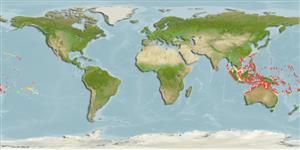Issue
The synonym P. quadrispinosa (Weber, 1913) is valid and redescriberd according to Johnson & White, 2012 (Ref. 90268).
Environment: milieu / climate zone / depth range / distribution range
Ecología
marino asociado a arrecife; rango de profundidad 0 - 100 m (Ref. 128797). Tropical; 30°N - 24°S
Indo-West Pacific: India and Sri Lanka to Tonga (Ref. 53797); , Ryukyu Islands and the Great Barrier Reef to the Marshall Islands and Samoa. Recently recorded from
Tamaño / Peso / Age
Maturity: Lm ? range ? - ? cm
Max length : 24.0 cm TL macho / no sexado; (Ref. 48636)
Espinas dorsales (total): 4 - 5; Radios blandos dorsales (total): 20-21; Espinas anales 1; Radios blandos anales: 17. A row of small blackish spots in outer third of anal fin (Ref 42740). Males develop a conspicuous ocellus on each side of the nape (Ref. 1602). Young are best identified by the patch of small spots on the cheek that usually remains evident in adults (Ref. 48636).
Inhabits both clear lagoon and seaward reefs, in areas of open sand and rubble as well as on rocky surfaces between coral heads. Also in current prone channels (Ref. 48636). May be found solitary or form small groups (Ref. 90102).
Life cycle and mating behavior
Madurez | Reproducción | Puesta | Huevos | Fecundidad | Larva
Randall, J.E., G.R. Allen and R.C. Steene, 1990. Fishes of the Great Barrier Reef and Coral Sea. University of Hawaii Press, Honolulu, Hawaii. 506 p. (Ref. 2334)
IUCN Red List Status (Ref. 130435)
Threat to humans
Harmless
Human uses
Más información
Nombres comunesSinónimosMetabolismoDespredadoresEcotoxicologíaReproducciónMadurezPuestaAgregación para la puestaFecundidadHuevosEgg development
ReferenciasAcuiculturaPerfil de acuiculturaRazasGenéticaElectrophoresesheritabilidadEnfermedadesProcesamientoNutrientsMass conversion
Herramientas
Special reports
Download XML
Fuentes de Internet
Estimates based on models
Preferred temperature (Ref.
123201): 26.1 - 29, mean 28 °C (based on 586 cells).
Phylogenetic diversity index (Ref.
82804): PD
50 = 0.5000 [Uniqueness, from 0.5 = low to 2.0 = high].
Bayesian length-weight: a=0.00692 (0.00311 - 0.01538), b=3.06 (2.88 - 3.24), in cm total length, based on LWR estimates for this Genus-body shape (Ref.
93245).
Nivel trófico (Ref.
69278): 3.6 ±0.4 se; based on size and trophs of closest relatives
Generation time: 1.4 ( na - na) years. Estimated as median ln(3)/K based on 1
growth studies.
Resiliencia (Ref.
120179): Alto, población duplicada en un tiempo mínimo inferior a 15 meses (Preliminary K or Fecundity.).
Fishing Vulnerability (Ref.
59153): Low vulnerability (18 of 100).
Nutrients (Ref.
124155): Calcium = 87.2 [47.6, 133.7] mg/100g; Iron = 0.685 [0.432, 1.101] mg/100g; Protein = 18.2 [15.9, 20.1] %; Omega3 = 0.0982 [, ] g/100g; Selenium = 36.4 [19.8, 69.6] μg/100g; VitaminA = 70.1 [25.2, 189.7] μg/100g; Zinc = 1.4 [1.0, 2.0] mg/100g (wet weight);
